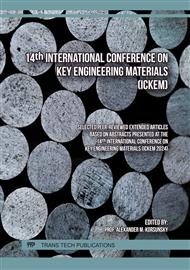[1]
Parque Nacional Galápagos et al., "Informe anual ingreso de visitantes a las áreas protegidas de Galápagos del año 2022.," Galápagos - Ecuador, 2022.
Google Scholar
[2]
B. Hayman, "Response of Sandwich Structures to Slamming and Impact Loads," in Composite Materials in Maritime Structures, Cambridge University Press, 1993, p.161–177.
DOI: 10.1017/CBO9780511751844.010
Google Scholar
[3]
Y. J. Kim, I. Yoshitake, and R. Liu, "Composite hull structures subjected to wave-induced slamming impact," Jan. 2014.
DOI: 10.1177/0731684413499831
Google Scholar
[4]
Z. Qin and R. C. Batra, "Local slamming impact of sandwich composite hulls," Int J Solids Struct, vol. 46, no. 10, p.2011–2035, May 2009.
DOI: 10.1016/j.ijsolstr.2008.04.019
Google Scholar
[5]
G. K. Kapsenberg, "Slamming of ships: where are we now?," Philosophical Transactions of the Royal Society A: Mathematical, Physical and Engineering Sciences, vol. 369, no. 1947, p.2892–2919, Jul. 2011.
DOI: 10.1098/rsta.2011.0118
Google Scholar
[6]
P. R. Townsend Valencia, "Comportamiento a impacto de materiales compuestos sometidos a fenómenos de slamming en embarcaciones de alta velocidad," Universidad Politécnica de Madrid, 2018.
DOI: 10.20868/UPM.thesis.52439
Google Scholar
[7]
R. S. Kumar and R. Talreja, "A continuum damage model for linear viscoelastic composite materials," Mechanics of Materials, vol. 35, no. 3–6, p.463–480, Mar. 2003.
DOI: 10.1016/S0167-6636(02)00265-X
Google Scholar
[8]
M. A. Zocher, D. H. Allen, and S. E. Groves, "Stress analysis of a matrix-cracked viscoelastic laminate," Int J Solids Struct, vol. 34, no. 25, p.3235–3257, Sep. 1997.
DOI: 10.1016/S0020-7683(96)00206-5
Google Scholar
[9]
P. Townsend, J. C. Suárez, and P. P. Cea, "The use of viscoelastic sheets, and their future in the shipbuilding of planing hulls of GFRP," in Proceedings of the LACCEI international Multi-conference for Engineering, Education and Technology, Latin American and Caribbean Consortium of Engineering Institutions, 2019.
DOI: 10.18687/LACCEI2019.1.1.9
Google Scholar
[10]
P. Townsend, J. C. Suárez Bermejo, P. Pinilla, and N. Muñoz, "Is the Viscoelastic Sheet for Slamming Impact Ready to Be Used on Glass Fiber Reinforced Plastic planing Hull?," Applied Sciences, vol. 10, no. 18, p.6557, Sep. 2020.
DOI: 10.3390/app10186557
Google Scholar
[11]
P. Townsend, J. C. Suárez-Bermejo, and Á. Rodríguez-Ortíz, "A Methodology for Evaluating the Progression of Damage in a Glass Fibre Reinforced Polymer Laminate Subjected to Vertical Weight Drop Impacts," Polymers (Basel), vol. 13, no. 13, p.2131, Jun. 2021.
DOI: 10.3390/polym13132131
Google Scholar
[12]
P. R. Townsend Valencia, J. C. Suárez Bermejo, P. Pinilla Cea, and E. Sanz Horcajo, "Evaluation of the Damage in Composite Materials Modified with Viscoelastic Layers for the Hull of Boats Subjected to Slamming Impacts," in Proceeding of the VI International Ship Design & Naval Engineering Congress (CIDIN) and XXVI Pan-American Congress of Naval Engineering, Maritime Transportation and Port Engineering (COPINAVAL), Cham: Springer International Publishing, 2020, p.347.
DOI: 10.1007/978-3-030-35963-8_29
Google Scholar
[13]
P. Townsend, J. C. Suárez-Bermejo, E. Sanz-Horcajo, and P. Pinilla-Cea, "Reduction of slamming damage in the hull of high-speed crafts manufactured from composite materials using viscoelastic layers," Ocean Engineering, vol. 159, p.253–267, Jul. 2018.
DOI: 10.1016/j.oceaneng.2018.04.029
Google Scholar
[14]
BASF, "Palatal CO P4 Datasheet," Santiago de Chile, 2019.
Google Scholar



